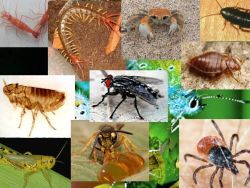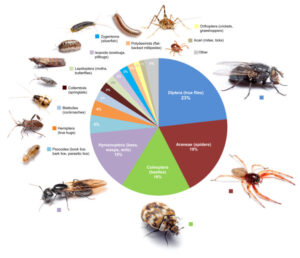Aside from pets, family members, or short or long term guests, many of us often go weeks without seeing another living thing in our homes. But appearances can be deceiving. We are, in fact, surrounded by arthropods—insects, spiders, mites, centipedes, and other animals with hard external skeletons and jointed legs. They are the most successful animals on the planet, and the walls of our homes, that  shield us from the elements, are no barriers to them. In fact, these creatures are incredibly adaptable, so the habitats we create for ourselves quickly become their habitats.
shield us from the elements, are no barriers to them. In fact, these creatures are incredibly adaptable, so the habitats we create for ourselves quickly become their habitats.
Through all of human history, insects and their relatives (collectively known as arthropods) have been our constant companions. We compete with them for food, use them as resources, and – whether we like it or not – share our homes with them.
In the first systematic census of its kind, a team of entomologists, working under the program, Arthropods of our Homes , combed through 50 American houses for every arthropod they could find, and discovered a startling amount of diversity. Each home had between 3 2 and 211 species, belonging to between 24 and 128 families. These bugs are our closest creaturely neighbors, and we barely register the existence of most of them.
2 and 211 species, belonging to between 24 and 128 families. These bugs are our closest creaturely neighbors, and we barely register the existence of most of them.
In this study the most commonly found arthropods were flies, spiders, beetles, ants and book lice. Of course, seasonality, climate and physical environment (rural, urban or city) make a difference in the number and type of these creatures that turn up in our homes, but the fact is they are there. More studies are now taking place throughout the U.S. and in other countries to see just what we are really living with.
“I hope this doesn’t put fear in people’s minds that they’re being overrun or that they live in unclean homes,” says Matthew Bertone from North Carolina State University, who led the study. “People have been living with these animals for centuries. This is just something that is.”
Learn more about Arthropods: http://robdunnlab.com/projects/arthropods-of-our-homes/learn-more-about-your-arthropods/
Arthropods of the great indoors: https://peerj.com/articles/1582/
Arthropods Invade Our Homes: http://ijpr.org/post/arthropods-invade-our-homes#stream/0
Need help getting rid of unwanted pests? We have the Power! https://www.corkyspest.com/
 800-901-1102
800-901-1102
0 Comments